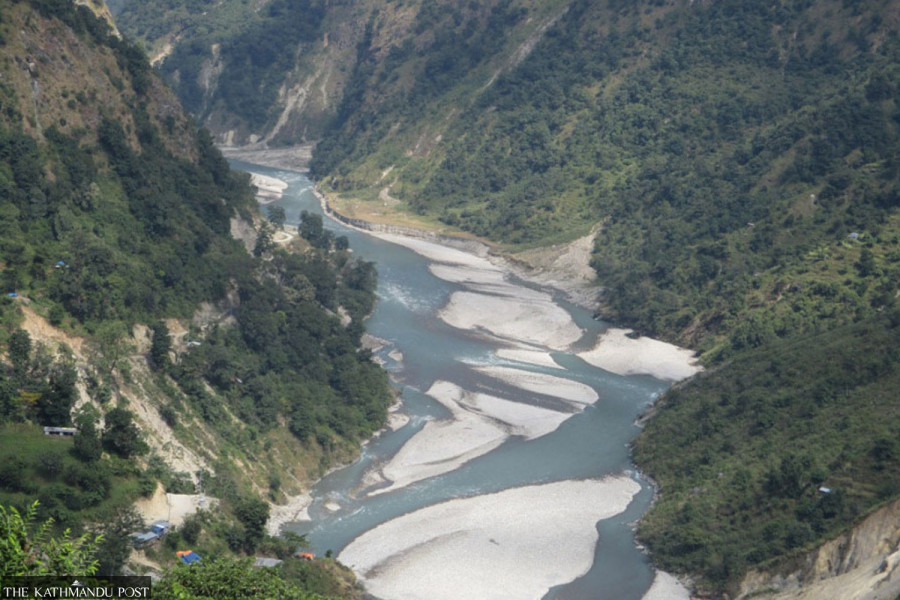
Construction of the hydropower plant is expected to take eight years and $2.6 billion. Post File Photo
The government has decided to set up a separate company to develop the Budhi Gandaki Hydropower Project, a storage-type hydropower project, which will be the country’s largest hydro project once it is built. The project site is in Gorkha and Dhading districts.
The project, an energy security for Nepal for next decades, has been in limbo for over a decade due to the uncertainty over its funding modality. The storage-type hydropower project will store the water in the rainy season and use it to produce energy in the dry season.
Nepal still has been suffering a power deficit in the dry season—from November to February—when water flow in the rivers drops and snow-capped mountains don't melt. The deficit currently is met by imports from India.
A Cabinet meeting on Tuesday approved the Energy Ministry’s proposal to set up the company.
The 1,200 MW hydropower project is estimated to cost $2.6 billion.
Construction is expected to take eight years.
Energy Minister Pampha Bhusal told the Post that now decks have been cleared for setting up a company to build the much-awaited project.
“A separate company will be registered. An executive committee representing experts from diverse backgrounds will be formed to oversee the project,” said Bhusal. “The company will invite an international consulting firm to prepare tender documents.”
The government is yet to decide on the funding modality.
Minister Bhusal said that the company will explore all kinds of viable options—including the funding modality that may be either through domestic resources or other sources.
The initial paid-up capital of the company will be Rs60 billion.
The government entities will put the money in the company, including the ministries of energy and finance as well as the Nepal Electricity Authority, according to the officials privy to the matter.
Even locals and the private sector will get an opportunity to invest, the officials said.
The project will be developed through an international competitive bidding process to maintain transparency, said Bhusal.
A seven-member board will be formed representing ministries, and other three independent experts. One female representation on the board is mandatory.
The project is located about 2 kilometers upstream the Trishuli-Budhi Gandaki confluence at the cross junction of the Gorkha and Dhading districts, about 80 km west of Kathmandu.
It is one of the most talked-about projects but not free of controversy.
The first feasibility study was conducted in 1984 as it was viewed as a mutually beneficial project for both Nepal and India.
But the project never came out of the drawing board until the second feasibility study was completed in 2014.
In 2017, the then Pushpa Kamal Dahal government awarded a contract to build the project without competitive bidding to China Gezhouba Group Corporation (CGGC) under the engineering, procurement, construction and financing (EPCF) modality.
The decision to award the contract to the Chinese developer was quashed by the then Sher Bahadur Deuba government in November 2017, saying that there were some procedural flaws while awarding the contract.
Again in September 2018, the project fell into politicking. The then KP Sharma Oli administration decided to rope in the Chinese company, reverting the Deuba government’s decision to develop the project with internal resources.
In April this year, the Sher Bahadur Deuba administration decided to revoke the license issued to CGGC to develop the project. At that time Minister Bhusal had announced that the project would be built by mobilizing domestic resources.
The exact cost of the project has been expected to triple due to inflation as well as the strengthening of the US dollar, according to officials.
“The exact cost of the project has not been ascertained,” said Bhusal. “We are reassessing the cost.”
After the Deuba government scrapped the agreement with the Chinese company in November 2017, it floated plans to build the project using domestic financial resources via the state-owned Nepal Electricity Authority.
Subsequently, a committee was formed under the then National Planning Commission vice-chair Swarnim Wagle to explore financing options to build the power plant.
The Wagle-led committee had suggested that the government develop the project on its own by providing viability gap funding, covering around one-third of the project development cost.
The Cabinet meeting during the Deuba administration approved the committee report and agreed to provide the gap funding.
But the plan never materialised as the government changed before the decision could be minuted.
Then the new administration under Oli, who had publicly criticized Deuba’s decision to scrap the deal with the Chinese company, disowned the previous administration’s decision.
The government has so far distributed Rs34.6 billion in compensation for 48,900 ropanis of land acquisitioned for the project.
The storage project will generate 3,383 GWh of energy annually.
The key project structure is a double curvature arch dam that rises 263 metres above the foundation. It will create a lake behind it to store water to turn the turbines of the 1200-megawatt plant.













